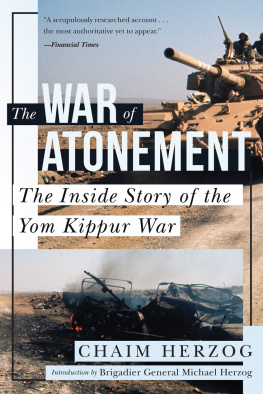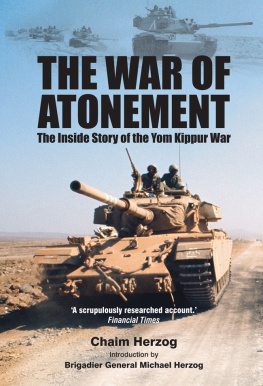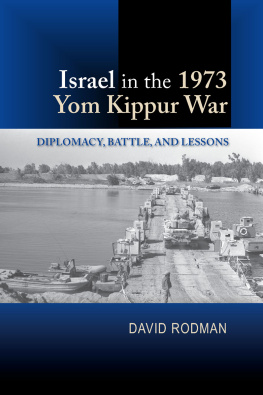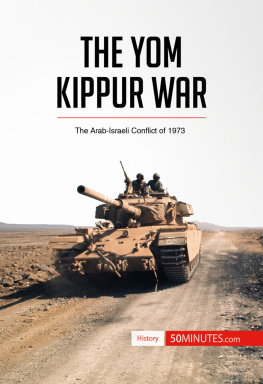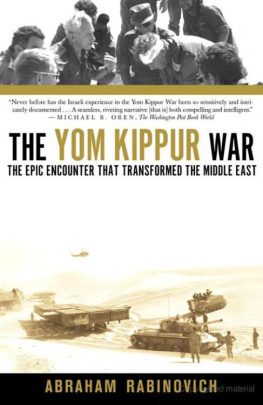


Copyright 1975, 2003, 2018 by Chaim Herzog
Introduction Copyright 2003, 2018 by Michael Herzog
First Skyhorse Publishing edition Copyright 2018
All rights reserved. No part of this book may be reproduced in any manner without the express written consent of the publisher, except in the case of brief excerpts in critical reviews or articles. All inquiries should be addressed to Skyhorse Publishing, 307 West 36th Street, 11th Floor, New York, NY 10018.
Skyhorse Publishing books may be purchased in bulk at special discounts for sales promotion, corporate gifts, fund-raising, or educational purposes. Special editions can also be created to specifications. For details, contact the Special Sales Department, Skyhorse Publishing, 307 West 36th Street, 11th Floor, New York, NY 10018 or .
Skyhorse and Skyhorse Publishing are registered trademarks of Skyhorse Publishing, Inc., a Delaware corporation.
Visit our website at www.skyhorsepublishing.com.
10 9 8 7 6 5 4 3 2 1
Library of Congress Cataloging-in-Publication Data is available on file.
Cover design by Rain Saukas
Cover photo credit: AP Images
Print ISBN: 978-1-5107-3879-9
Ebook ISBN: 978-1-5107-3880-5
Printed in the United States of America.
Contents
Maps
Illustrations
Between
Introduction
by Brigadier General Michael Herzog
THE OCTOBER 1973 Arab-Israeli War (known in Israel as the Yom Kippur War, namely the War of Atonement) was a breaking point and watershed in the history of the Arab-Israeli conflict.
It was the last multi-front comprehensive war waged between Israel and its Arab neighbours, although the Middle East was still to witness further serious outbreaks of violence and military confrontations.
This book was written soon after the War, in 1974, and was published in 1975. The author, my late father, relied on all the relevant evidence that was then available. He conducted comprehensive interviews with Israeli leaders, army officers and ordinary soldiers; he toured the battlefields; and studied a large number of books and articles that had already been published. In writing the book, he gave expression to his vast experience as a soldier, general and intelligence expert as well as a military and political analyst and commentator. In fact, the book has become a classic on the history and wars of the Middle East, been translated into numerous languages and gained international recognition and praise.
Almost three decades have now passed since the War and the political environment in which we live has undergone great change. The world is no longer polarised as it was during the Cold War; Israel and Egypt, the largest and most important of the Arab states, have been party to a peace agreement for more than two decades; and Israel and its other neighbours have embarked upon a brittle peace process, fraught with crises and violent upheaval. All of the then leaders have climbed down from the stage and the technology and art of war have meanwhile taken on a somewhat different face.
Nevertheless, in hindsight it seems that the book has lost none of its validity. On the contrary, on reading it again, it seems like a wine that has improved with age. A huge quantity of material on the War of Atonement has been published in the interceding years, including the memoirs of some of the leaders who were involved (such as Saddat, Golda Meir and Dayan), the versions of senior military commanders (such as the book by Saad-A-Din Shazali, the Egyptian Chief of Staff during the War) and other first-hand material. This has added details that were previously unknown, and testimony of historical weight. Nevertheless, in the final analysis this does not impair the validity of the picture painted in this book, but rather reinforces it. The book has withstood the tests of time and continues to excel in its ability to portray a comprehensive, yet sharp and accurate, picture.
The seeds of the War of Atonement were sown in the Six Day War which preceded it in 1967. Israels brilliant military victory gave rise to a delusion of power on the Israeli side and a deep sense of humiliation on the Arab side. The War of Atonement restored a measure of balance to this picture and thereby constituted an important milestone in the process of transition from war to peace. The Arab side won back a degree of pride by daring to instigate a military confrontation with Israel and scoring an initial success, despite ultimately suffering a military defeat. At the same time the War sobered its long-standing belief that it could ultimately defeat Israel by armed force, since it could not have hoped for a better start to the War than it achieved in 1973. On the Israeli side, the War demonstrated both the limits of force and the risks of conceit, complacency and stagnation. Indeed, just a few years after the War President Saddat came to Jerusalem, and Israel and Egypt, after so bitterly shedding each others blood, signed a formal peace agreement. More than two decades have since elapsed, during which time not a soldier has fallen in an Egyptian-Israeli military confrontation.
As the book describes, President Saddat planned the War of Atonement as a model previously unknown in the area, namely as a military initiative with limited military goals (albeit a fully-fledged war in terms of the means used), aiming to motivate a diplomatic process in the wake of the military shockwaves. The Egyptian offensive, therefore, was planned in careful detail only in its initial stages but not beyond them. In vehement dispute with his Chief of Staff, Saddat therefore also refused to pull his forces back from the east bank of the Suez Canal in the face of Israels crossing to its west bank in a pincer movement. Saddats army suffered a military defeat but ultimately, aided by the USA, the Egyptian leader was able to gain diplomatic success, from which he later advanced towards full peace in exchange for all the territory lost by Egypt in 1967. On the other hand, Israel gained an impressive military victory, bearing in mind it was initially taken by surprise, but had to pay a considerable diplomatic price, alongside the heavy loss of life and the serious damage to public morale.
In contrast to Saddat, his Syrian colleague Assad did not share his strategy and even bore a grudge against Saddat for having used it. Close to thirty years have passed since the War and the question still remains as to whether and to what extent Assad the lessons of Saddats policy of war and peace are still applicable to the new generation of Middle Eastern leaders and the current strategic balance in the region.
The War of Atonement put under severe scrutiny Israels security doctrine, that had first been shaped back in the days of David Ben-Gurion, Israels first Prime Minister, and prevailed ever since. This doctrine was designed to provide an answer to the fundamental reality of the few against the many, to Israels difficulty in keeping a large regular army on its borders and of withstanding a protracted war as well as the possibility of a simultaneous offensive against Israel on several fronts. The Israeli concept of security was therefore based on the fundamental elements of deterrence (relying also on American backing), early warning, air supremacy to provide a brake and response in the face of a surprise attack, a sophisticated organisation of reserve units capable of being rapidly mobilised and reaching the front in time (due to early warning), taking the battle into enemy territory and striving for as rapid a decision as possible.
Next page
